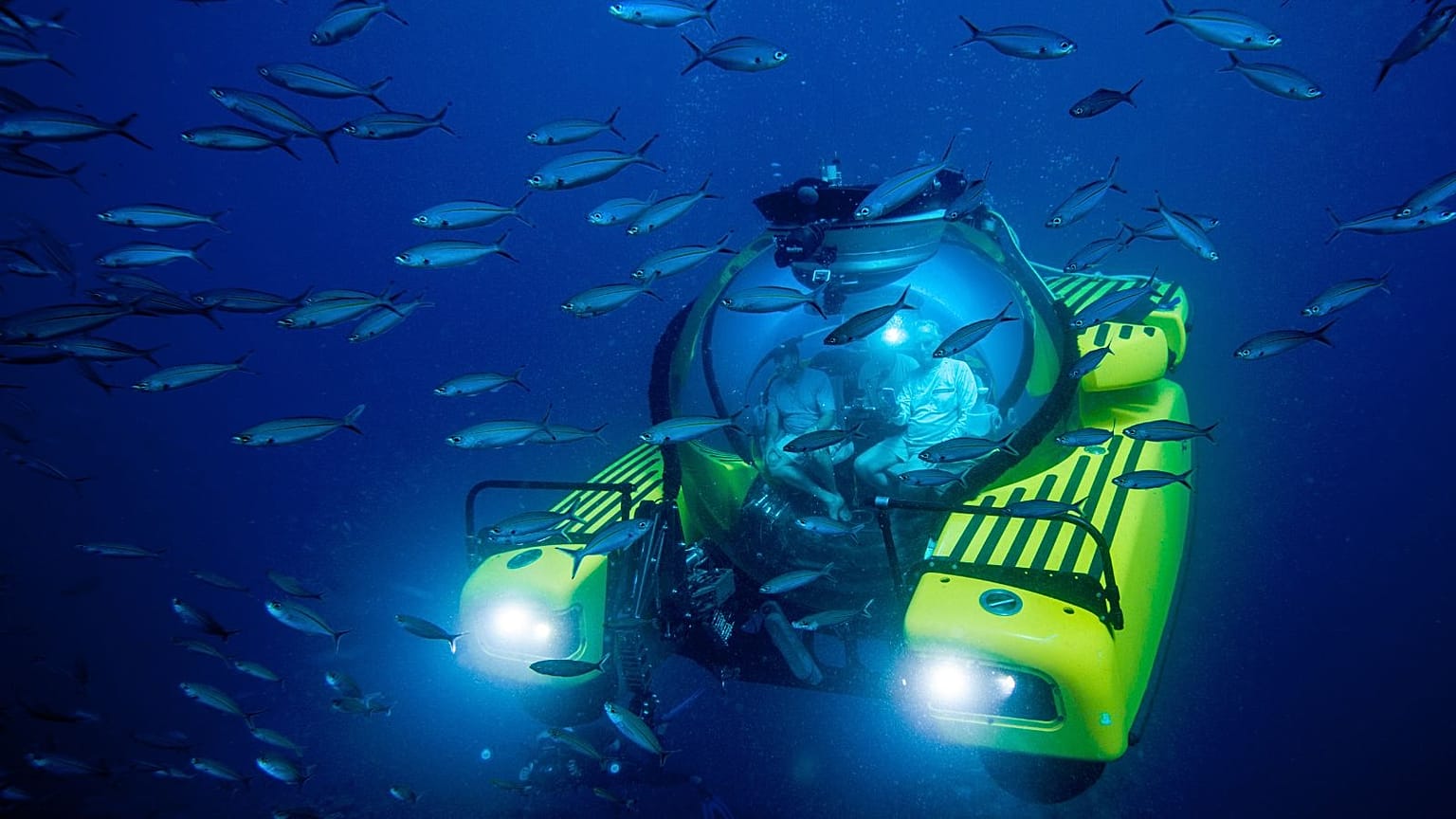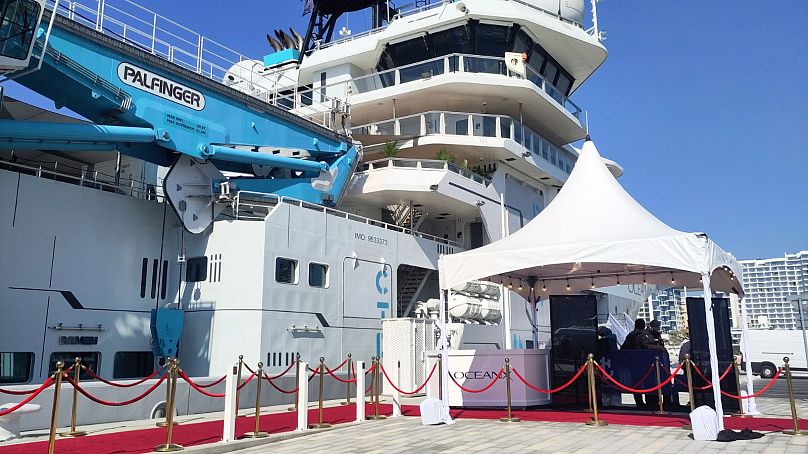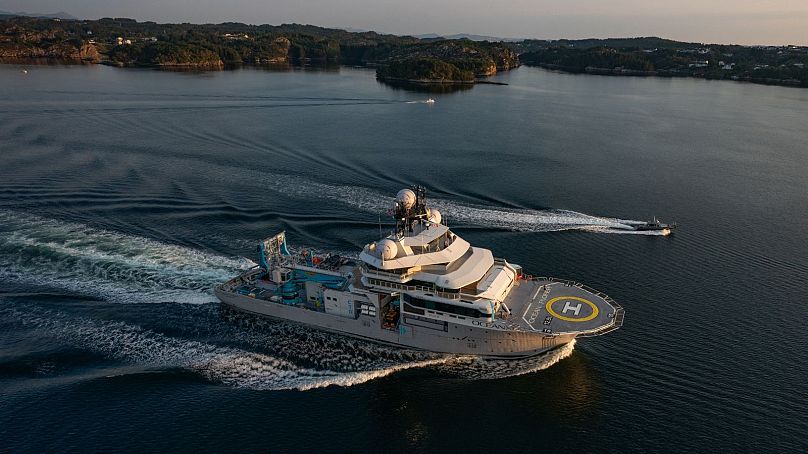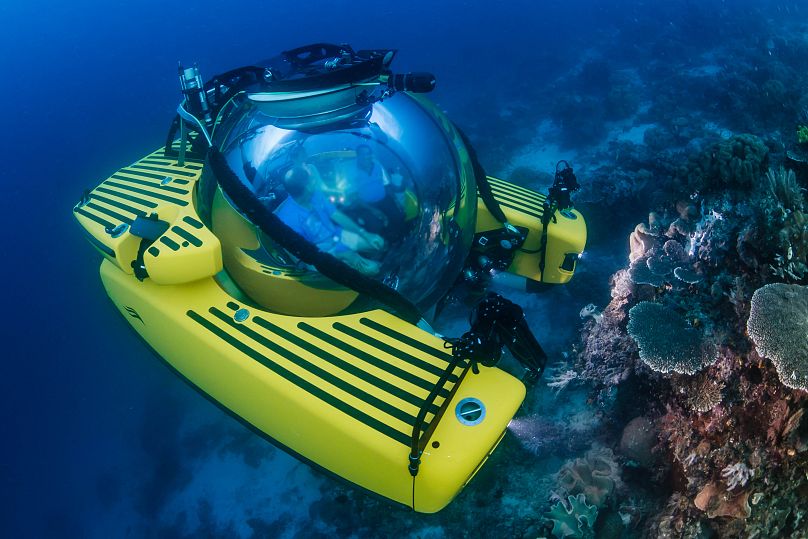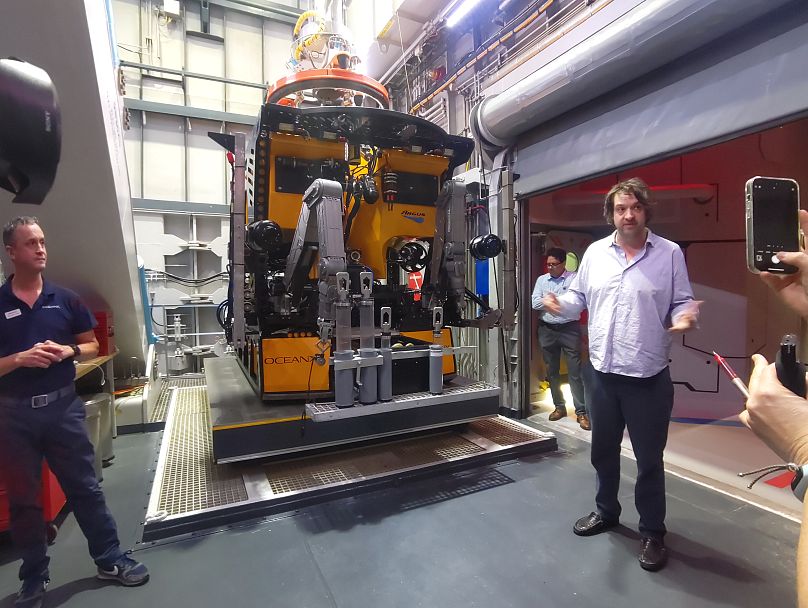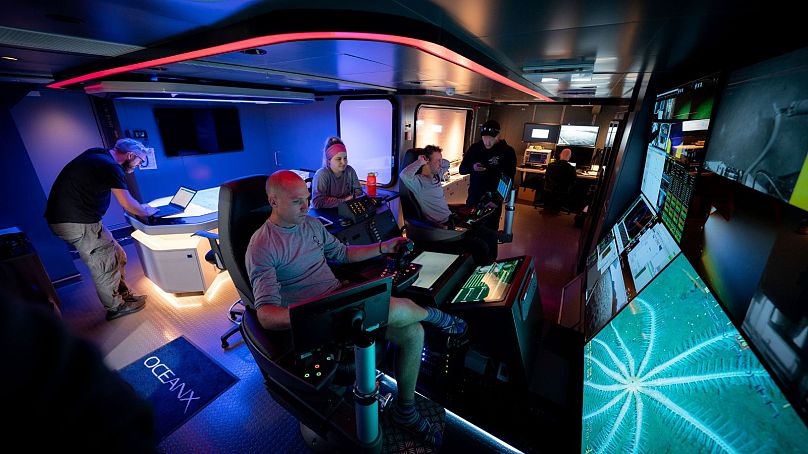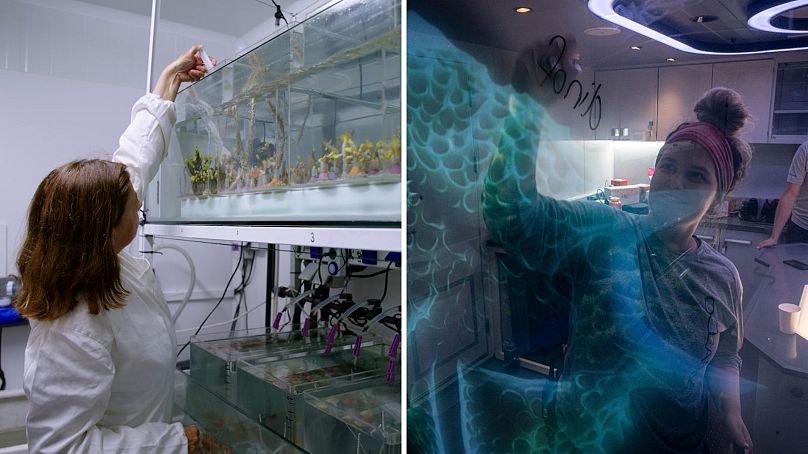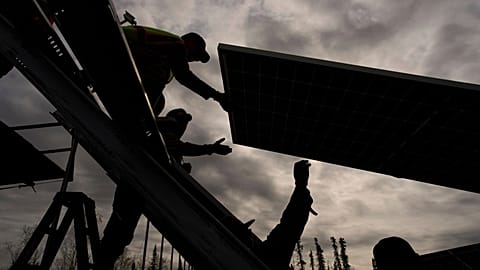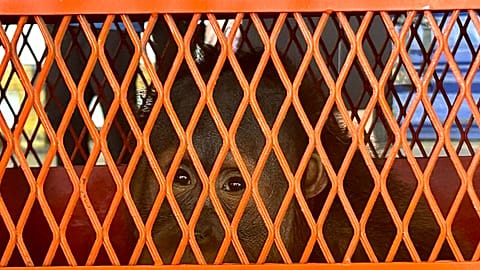A state of the art ship is on a mission to “explore the ocean and bring it back to the world”. How valuable is this deep sea philanthropy?
OceanXplorer stretches the notion of what a ship can be. At 87 metres long, it holds two deep sea submersibles - one for scientists, the other for media - and laboratories lit up like film sets.
The red carpet is rolled out when I visit the vessel in December, during the UN climate summit in Dubai. It’s docked down a guarded arm of the harbour, and has for days been hosting a stream of esteemed guests like Bill Gates and Jordanian royalty.
This is the world’s most advanced media and research vessel, according to OceanX - a nonprofit arm of Dalio Philanthropies, which ‘furthers the diverse philanthropic interests of Dalio family members’. Their wealth flows from Ray Dalio, the 74-year-old American billionaire who founded Bridgewater Associates, the world’s largest hedge fund.
“The combination of the two [science and media] is our secret sauce,” says Mark Dalio, his son and co-CEO of Ocean X, describing the venture’s USP to journalists on another cloudless day in the emirate.
What is OceanX?
There’s an obvious echo of SpaceX in the name; the US aerospace company founded by Elon Musk with the aim of making humans a “spacefaring civilization.”
Ray Dalio has opted out of the billionaire space race, but there’s a competitive edge to his decision to go in the opposite direction. “Ocean exploration seems to me much more exciting and important than space exploration,” he has told the Financial Times among others. “You’re not going to see any aliens in outer space but you will see aliens underneath.”
Framing the radically mysterious depths of the sea as the final frontier of American exploration won’t sit well with everyone. But if you’ve ever marvelled at a deep sea documentary, the appeal is relatable and the premise true: only 5 per cent of the ocean has been explored and charted by humans, according to the UN body for ocean science.
OceanX’s mission is “to support scientists to explore the ocean and to bring it back to the world through captivating media.”
It was founded in 2016 but the Dalios’ marine roots stretch back further. In 2011 Ray bought a research vessel called Alucia and a bubble sub, which the following year was used by a team of scientists to record the first ever footage of the elusive giant squid in its natural habitat.
Mark, who was then working as an associate producer at National Geographic’s television network, pitched his father the idea of a multimedia outfit to chronicle Alucia’s adventures. They had the honour of taking UK national treasure David Attenborough on his first deep sea dive of the Great Barrier Reef in 2015.
Alucia Productions morphed into OceanX Media. And Alucia itself (which marketed for more than €18 million in 2018) was replaced by OceanXplorer - a former Norwegian oil survey ship which underwent extensive renovation after Dalio bought it. OceanX does not say how much its state-of-the-art diesel vessel cost, but one superyacht site values it at around €186 million and puts running costs at a tenth of that per year.
“It’s not a luxury yacht,” OceanX’s co-CEO and Chief Science Officer Vincent Pieribone tells reporters in Dubai. “The fact that our country [the US] doesn't have a ship like this is a national embarrassment.”
‘We're not a tourist attraction’: What are OceanX’s submersibles for?
Our tour starts in OceanXplorer’s sub hanger, face to face with the two bubble subs. These huge globules of plexiglass can carry their small crews 1,000 metres deep.
One is optimised for researchers, with modular equipment including a machine that is “essentially a vacuum cleaner,” sub pilot Colin explains, sucking up samples from the seafloor to be processed in the ship’s onboard labs.
A range of cameras are affixed to the other sub, capable of capturing the smallest marine creatures as well as wide angle shots of the science sub in action. It can also broadcast in real time by sending video signals to the surface on beams of light. A marine biologist dialled into the World Economic Forum in Davos last month from deep below the Seychelles, where OceanXplorer is currently based.
Submersibles (and billionaires) got a bad press last year, with the fatal implosion of OceanGate’s ‘Titan’ sub to view the Titanic. “Of course it's put a spotlight on the industry,” says OceanX’s ROV team leader Andrew Craig. “But we operate these as scientific machines as opposed to pleasure vessels… We're not a tourist attraction. We're a genuine scientific research vessel.”
The ROV (remotely operated vehicle) can descend 6,000 metres while tethered to a cable, sampling even more remote spots such as hydrothermal vents and underwater volcanoes.
Pulling all of this tech together on one vessel is what makes OceanXplorer so unique, Mark Dalio tells us, from inside the ship’s mission control room or “nerve centre.” In front of gamer-style chairs, dozens of screens are lit up with real time footage from all its moving parts - more than I can parse as a non-scientist, but it certainly looks the part.
What do OceanX’s science team do?
Whatever is retrieved from the deep is brought up to the dry lab. The equipment is smaller here, but no less exacting. There’s a 3D scanner with submillimetre resolution which can create a digital twin of a fish, for example, storing it in an online database.
Much of this work involves filling in the blanks in our understanding. Not necessarily finding new species - though Science Program Director Mattie Rodrigue says “[that] happens a lot - to us, specifically.” But the team often come across species that haven’t been publicly documented yet, in which case they can record its reference genome - essentially digitising the DNA.
They can also take environmental DNA (eDNA) from the water, capturing an animal’s genetic fingerprint through the cells it sheds. With enough information, they can even tell whether a fish is pregnant or stressed - revealing clues about how it is adapting to changing conditions.
“Ground truthing” or “ocean truthing climate models” is how Rodrigue describes their broader work. In the UAE, for example, oceanography relies heavily on satellite data which means that predictions can be wide of the mark. While in town for COP28, OceanX partnered with scientists at New York University Abu Dhabi to investigate the distribution of coral larvae, and the possibilities of breeding heat resistant coral.
“We see the vessel and OceanX as on the frontlines,” says Mark, “gathering all this data to better inform the science community and governments how things are changing.”
Lights, camera, action: How is OceanX sharing its findings with the world?
Dr Pieribone, a neuroscience professor at the Yale School of Medicine, laments that while there’s a lot of climate science being done, the thousands of academic papers published a year are simply not reaching people.
So how do you cut through? OceanXplorer is the vehicle, “combining functionality with the look of a film set,” Mark says.
Film director James Cameron (of Titanic fame) is another big name in OceanX’s circle - he has long been fascinated with the ocean and the technology needed to plumb its depths. He advised the team on how to rig OceanXplorer up; bioluminescent coloured lights loop around the ceilings, with hangars for running overhead cameras. Lights are embedded in the tables too to illuminate researchers’ reactions, broadcasting the highs and lows of scientific pursuit.
There’s up to 72 people on the ship when it’s in full swing, and a good number of those work on the media side. OceanX has more than 4 million followers on TikTok, where the team often post fun videos from their expeditions, distilling nuggets of ocean science and ship life for Gen Z.
Other parts of the emotional landscape around OceanX can feel a bit amped up. Is it really the case, in Mark’s words, that they need to “inspire the public to fall in love with oceans”? Or, as Dr Pieribone suggests, that OceanXplorer is the antidote to assaults on climate scientists in the US, helping people see the humanity of experts?
Should private money be funding ocean research?
At the screening of a new National Geographic series on the helideck, Mark Dalio’s role in making it is described as the fulfilment of a “lifelong dream.”
Does it matter that personal ambition is mixed into OceanX’s purpose? That this most advanced vessel of its kind is primarily in service of the Dalio family’s philanthropic interests?
“For better or worse,” Steven A. Edwards, then a policy analyst at the American Association for the Advancement of Science, wrote a decade ago, “the practice of science in the 21st century is becoming shaped less by national priorities or by peer review groups and more by the particular preferences of individuals with huge amounts of money to give.”
In its defence, OceanX is a collaborative enterprise. The transnational nature of ocean travel - OceanXplorer is registered in the Marshall Islands - means that permits have to be secured months in advance, and the outreach with academic institutes and NGOs is carefully tied in.
Most big public ocean organisations, like the Intergovernmental Oceanographic Commission (UNESCO Ocean) have collaborated with OceanX in some capacity. One research organisation in the UK declined to comment on oceanographic funding given its association.
America’s National Oceanic and Atmospheric Administration (NOAA) Ocean Exploration director Jeremy Weirich, however, told Euronews Green that he “absolutely welcomes” the efforts of organisations like OceanX, Schmidt Ocean Institute, Ocean Exploration Trust, and other philanthropic and private operators.
“For me, it's not a question of "either/or" but a case for "and," meaning we need both the philanthropically supported and the publicly funded maritime operators acquiring valuable data and information about the unknown ocean,” he adds.
“The at-sea exploration community is still relatively small, while the unexplored and poorly known areas of the ocean remain vast. Fortunately, we're already working together to consider ways to coordinate our unique operations and activities better.”
In its latest PR missive from the Seychelles, OceanX stresses its collaboration with local scientists, “helping local researchers deliver major scientific findings about their own climate-sensitive region for the first time in history.”
Netted in the bullet points are a rich catch of record setting achievements, enviable shark sightings, and an exciting new headcount of dugongs.















